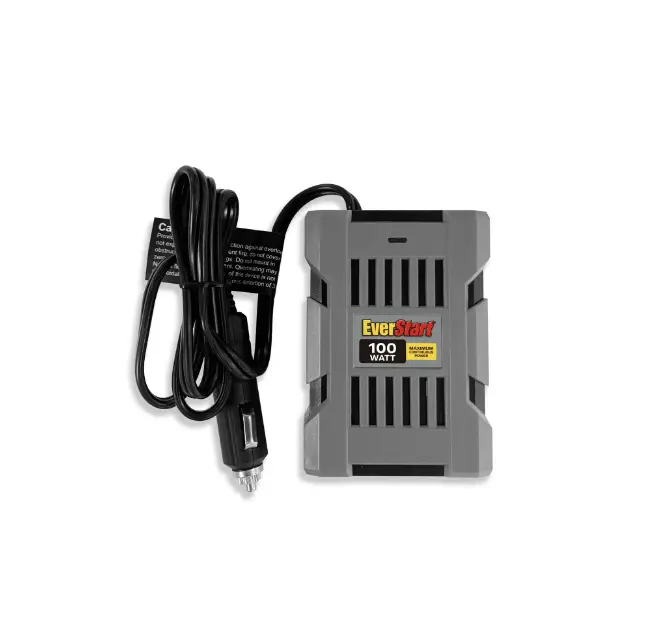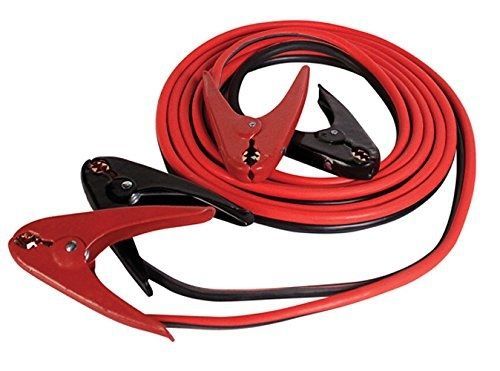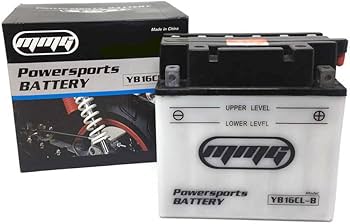
100 Watts Vehicle Power Inverter
- Two universal USB ports shared 5Volt 3.1Amp work with iPhone, iPad, Samsung and other mobile devices and accessories. 12 Volt cigar plug easily powered from the DC socket in the car.
- Power (green)/fault (red) LED indicator. Max continuous power for AC output: 100 Watts.
- High surge peak: 200 Watts. Input voltage: 13.8 Volt DC.
- Replaceable fuse: 12 Amp glass tube.
$14.87
Life on the road used to mean disconnecting from the comforts of home—especially when it came to powering our essential devices. That all changed when I discovered the game-changing little gadget that’s become my constant travel companion. After three years of relying on this pocket-sized powerhouse for everything from family road trips to remote work sessions, I’m excited to share my comprehensive guide to the Everstart 100 Watt Power Inverter.
Whether you’re a weekend warrior, digital nomad, or someone who simply wants to be prepared for anything, this affordable power solution might be exactly what you’ve been looking for. So buckle up as I dive into everything you need to know about this versatile device that turns your vehicle’s battery into a mobile power station for all your essential electronics.
What Exactly Is the Everstart 100 Watt Power Inverter?
Before I found the Everstart 100 Watt Power Inverter, I was constantly playing the “battery percentage game” during road trips. You know the one—frantically trying to conserve power on your phone while using GPS navigation, or watching your laptop slowly die during an important remote work session from your car.
At its core, the Everstart 100 Watt Power Inverter is a compact device that converts your vehicle’s 12V DC (Direct Current) power into standard 120V AC (Alternating Current) household electricity. This simple but brilliant technology allows you to plug in and power a wide range of devices directly from your car, truck, or RV.
The Everstart brand falls under Walmart’s lineup of automotive products, positioning this inverter as an affordable yet reliable option for everyday use. While it might not have the fancy features of some premium models costing three times as much, I’ve found it delivers impressive performance where it counts most—consistent, reliable power when you need it.
The Science Behind the Magic: How Does It Work?
I’m not an electrical engineer by any stretch, but understanding the basics of how the Everstart inverter works has helped me use it more effectively. In simple terms, the power inverter takes the 12V DC power from your vehicle’s battery (the same power that runs your car radio or charges your phone through the cigarette lighter) and converts it to 120V AC power—the same type that comes out of your wall outlets at home.
This conversion happens through an internal circuit that rapidly switches the DC current back and forth, creating an alternating current that mimics household electricity. The Everstart uses what’s called a “modified sine wave” output, which works perfectly fine for most devices but isn’t quite as “clean” as the pure sine wave electricity from your home outlets.
What impressed me most is how seamlessly this conversion happens. There’s no complicated setup—you simply plug the inverter into your vehicle’s 12V outlet (or directly to the battery for more demanding applications), and suddenly you have a standard household outlet ready to use.
Power on Demand: What Can You Actually Run With 100 Watts?
When I first purchased my Everstart inverter, I wasn’t entirely sure what “100 watts” actually meant in practical terms. After three years of regular use, I’ve developed a good feel for its capabilities.
The 100-watt rating indicates the continuous power the inverter can supply. It also has a peak power rating of around 200 watts, which allows it to handle the initial surge many devices require when first turned on.
Here’s what I’ve successfully powered with my Everstart 100W inverter:
- Smartphones and tablets (multiple devices simultaneously)
- Laptops (most models under 65W power requirements)
- Camera battery chargers
- Portable fans
- Small LED lighting
- Portable speakers
- CPAP machines (most travel models, though check your specific wattage requirements)
- Nintendo Switch and other portable gaming devices
However, I quickly learned its limitations as well. The following are generally beyond its capabilities:
- Hair dryers (typically 1000+ watts)
- Coffee makers (700+ watts)
- Toasters (800+ watts)
- Microwaves (700+ watts)
- Power tools (variable, but often 300+ watts)
- Large laptops with powerful GPUs (some gaming laptops exceed 100W)
Understanding these limitations is crucial—I once tried to power my wife’s hair dryer during a camping trip and immediately tripped the inverter’s safety shutdown. Learning what the Everstart can and can’t handle will save you frustration and potential damage to your devices.
The Laptop Question: Is It Suitable for Charging Your Computer?
As someone who frequently works remotely, this was perhaps my biggest question when purchasing the Everstart. The answer, I’ve found, is a qualified yes—with some important caveats.
Most modern laptops require between 45W and 65W of power, which falls comfortably within the Everstart’s 100W capacity. I’ve successfully charged my MacBook Air, Dell XPS 13, and Microsoft Surface devices without any issues. The inverter provides enough stable power for hours of productivity on the road.
However, there are some important considerations:
First, gaming laptops or high-performance workstations with powerful GPUs often require 100W or more, which pushes right up against (or exceeds) the inverter’s capacity. Using these laptops with the Everstart might work for basic tasks but could struggle during intensive operations.
Second, while the modified sine wave output works fine for most laptop chargers, some sensitive electronics might run slightly less efficiently or generate a bit more heat than usual. I haven’t experienced any problems with my devices, but it’s something to be aware of.
Third, I’ve noticed that when charging a laptop, it’s best not to connect too many additional devices to the inverter simultaneously. Staying comfortably below the 100W limit ensures stable performance.
Connectivity Options: The Plug and Play Experience
The Everstart 100W inverter features a straightforward connectivity setup that I’ve found perfectly adequate for my needs:
- One standard three-prong AC outlet (the same as your wall outlet)
- One 2.4A USB-A port for direct charging of USB devices
This combination provides good versatility for most situations. The USB port is particularly handy as it allows you to charge phones or tablets directly without using their wall adapters, freeing up the AC outlet for other devices.
The inverter itself connects to your vehicle in one of two ways:
- Via the included 12V cigarette lighter adapter cable (approximately 3 feet long)
- Through direct battery connection using alligator clips (sold separately or included in some packages)
For most of my everyday use—charging laptops, phones, or cameras during road trips—the cigarette lighter connection works perfectly. However, when camping or during longer power needs, I use the direct battery connection method for more stable power delivery.
Installation and Setup: Plug and Power in Seconds
One of the most appealing aspects of the Everstart inverter is its simplicity. Unlike larger inverters that require permanent mounting and direct wiring to your vehicle’s electrical system, the 100W Everstart is truly portable and requires essentially no installation.
Here’s my typical setup process:
- Plug the inverter into your vehicle’s 12V outlet
- Wait for the small indicator light to confirm power connection
- Plug in your device(s) to the AC outlet or USB port
- Power on your connected devices
That’s it! The entire process takes seconds, making it incredibly convenient for spontaneous use. The inverter is small enough (approximately 5 × 3 × 2 inches) to store in your glove compartment or center console when not in use.
For longer usage sessions, particularly when powering devices near the inverter’s capacity limit, I recommend starting your vehicle occasionally to prevent battery drain. The inverter draws power directly from your car’s battery, which will eventually deplete if the engine isn’t running to recharge it.
Safety Features: Protection for Your Devices and Vehicle
Despite its budget-friendly price point, I’ve been impressed with the safety features built into the Everstart inverter. These protections have given me confidence in connecting even my more expensive electronics:
- Overload protection: Automatically shuts down if you connect devices exceeding its capacity
- Over-temperature protection: Prevents damage from overheating during extended use
- Low battery shutdown: Protects your car battery from excessive discharge
- Short circuit protection: Guards against damage from faulty connected devices
- Cooling fan: Activates automatically when needed to maintain safe operating temperatures
These safety features have kicked in a few times during my ownership—most notably when I accidentally connected too many devices simultaneously. Rather than causing any damage, the inverter simply shut itself down safely, requiring a simple reset by unplugging and reconnecting.
The built-in cooling fan is relatively quiet during operation, though you’ll definitely notice it in an otherwise silent vehicle. I find the sound comparable to a laptop fan—present but not distracting.
Real-World Performance: My Experience After Three Years
After relying on my Everstart inverter for everything from daily commutes to cross-country road trips, I’ve developed a good sense of its real-world performance in various scenarios.
For everyday use—charging phones, tablets, or running small devices—it performs flawlessly. The inverter barely gets warm, the fan rarely needs to kick in, and power delivery remains stable.
During camping trips, where I’ve used it to power LED lighting, charge multiple devices, and even run a small portable fan, it’s been a genuine game-changer. The ability to tap into my vehicle’s power while enjoying the outdoors has dramatically improved our camping experience.
For professional use, I’ve conducted numerous video calls from my car using my laptop powered by the Everstart. While I initially worried about potential interference or power stability issues, I’ve experienced virtually no problems. The modified sine wave output has proven more than adequate for my professional devices.
Battery drain is an important consideration for any inverter. In my experience, using the Everstart for 1-2 hours with moderate loads (like a laptop) while the engine is off will consume some battery power but not enough to prevent starting the vehicle afterward. For longer sessions, I either start the engine periodically or use the inverter while driving.
The build quality has held up remarkably well over three years of regular use. The plastic housing shows some minor scuffs from being tossed in my console or backpack, but all functions continue to work perfectly. The cables and connections remain tight and reliable.
Troubleshooting Common Issues: When Things Don’t Go as Planned
While my experience has been overwhelmingly positive, I’ve encountered a few minor issues over the years. Here are the most common problems and their solutions:
1. Inverter Not Powering On
If your Everstart doesn’t show its power indicator light:
- Ensure your vehicle’s 12V outlet is active (some only work when the ignition is on)
- Check for a blown fuse in either the inverter or your vehicle’s 12V outlet
- Try a different 12V outlet if your vehicle has multiple
- Clean any debris or corrosion from the 12V plug
2. Inverter Shuts Down During Use
This is typically caused by:
- Device power requirements exceeding the 100W capacity
- Overheating during extended use
- Poor connection to the power source
- Low vehicle battery
The solution usually involves:
- Reducing the connected load
- Allowing the inverter to cool down
- Securing the connection to your vehicle’s power
- Starting your engine to recharge the battery
3. Connected Devices Charging Slowly
If devices seem to charge more slowly than with their wall adapters:
- Ensure you’re not approaching the 100W limit with multiple devices
- Check if the inverter is getting warm (which might trigger throttling)
- For laptops, some charging circuitry may operate more conservatively with modified sine wave power
4. Unusual Noise from Connected Devices
Occasionally, sensitive electronics may produce a slight humming noise when powered by a modified sine wave inverter. This is typically harmless but worth noting:
- Most modern electronics handle this without issue
- If the noise concerns you, consider a pure sine wave inverter instead (though at a higher price point)
The Economic Perspective: Is It Worth the Investment?
At around $20-30 (depending on sales and promotions), the Everstart 100W inverter represents exceptional value compared to many alternatives on the market. Higher-end 100W inverters can cost $50-100, while offering marginally better performance or additional features.
After three years of regular use, I can confidently say my Everstart has more than paid for itself in convenience alone. The ability to work remotely from my vehicle, charge essential devices during travel, and power small electronics while camping has proven invaluable.
Operating costs are essentially limited to the minimal additional fuel consumption when running your engine to maintain battery charge during extended use. This is negligible for most usage scenarios.
For warranty coverage, Everstart typically offers a one-year limited warranty. While this isn’t as generous as some premium brands, I’ve found the durability and reliability haven’t made warranty service necessary during my ownership.
Where to Purchase: Finding the Best Deal
As an Everstart product, this inverter is primarily sold through Walmart. You can find it:
- In Walmart’s automotive department
- On Walmart’s website
- Occasionally through third-party sellers on platforms like Amazon or eBay
Based on my experience monitoring prices, the best deals typically occur during:
- Black Friday/Cyber Monday sales
- Automotive accessory promotions
- Back-to-school sales periods
The regular retail price tends to be around $25-30, but I’ve seen it discounted to as low as $19.99 during promotions. Given its utility and durability, even the full retail price represents excellent value compared to competitor products.
The Competition: How Does It Stack Up?
The 100W power inverter market is surprisingly crowded, with options from Bestek, Krieger, POTEK, and numerous other brands. After researching alternatives and talking with friends who own different models, here’s how I feel the Everstart compares:
Advantages over competitors:
- Price point (typically 20-40% less expensive than comparable models)
- Simplicity and ease of use
- Compact size and portability
- Reliability and durability based on my long-term use
Areas where competitors might edge ahead:
- Some offer pure sine wave output (better for sensitive electronics but at 2-3× the price)
- Some feature additional outlets or USB ports
- Certain models include more sophisticated battery monitoring
- Premium brands may offer longer warranty periods
For my needs—and I suspect for most typical users—these competitive advantages don’t justify the significant price premium. The Everstart delivers excellent core functionality at an affordable price point.
Environmental Considerations: Efficiency and Impact
As we all become more conscious of our environmental footprint, it’s worth considering the efficiency of devices like power inverters. The conversion from DC to AC power inevitably involves some energy loss in the form of heat.
The Everstart, like most modified sine wave inverters in its class, operates at approximately 85-90% efficiency. This means that for every 100 watts of power drawn from your vehicle’s battery, about 85-90 watts are delivered to your devices, with the remainder lost as heat during the conversion process.
This efficiency is actually quite good for a budget inverter. Premium pure sine wave inverters might achieve 90-95% efficiency, but at significantly higher cost.
To minimize environmental impact when using the inverter:
- Only power essential devices
- Avoid leaving the inverter connected when not in use (it draws a small amount of standby power)
- For longer sessions, consider using the inverter while driving so your alternator provides power rather than depleting the battery
Perfect for Camping: My Outdoor Adventures
One of my favorite applications for the Everstart inverter has been enhancing our family camping trips. Traditional camping often means limited or no access to electrical power, but the Everstart has changed that equation.
During weekend camping excursions, we use the inverter to:
- Charge our phones for emergency communication
- Power small LED lighting for evening activities
- Recharge camera batteries to capture memories
- Run a small portable fan during hot summer nights
- Power a portable speaker for campsite music
The key is balancing power use with battery conservation. We typically use the inverter for 1-2 hours in the evening, then again briefly in the morning, starting the car occasionally to prevent battery drain. This approach has worked perfectly across dozens of camping trips.
For those planning extended off-grid use, I recommend:
- Starting your vehicle for 15-20 minutes every few hours of inverter use
- Prioritizing your most essential devices
- Considering a dedicated portable power station for longer trips
- Bringing a portable jump starter as a backup
Practical Tips: Making the Most of Your Inverter
After extensive use, I’ve developed some practices that help maximize the utility of the Everstart inverter:
- Position matters: Place the inverter in a well-ventilated area rather than a closed compartment to prevent overheating during extended use.
- Mind your vehicle’s battery: Most modern car batteries have 40-60 amp-hours of capacity. The Everstart at full load draws approximately 10 amps, meaning you can theoretically run it for 4-6 hours before depleting your battery. However, I recommend limiting to 1-2 hours unless the engine is running.
- Direct connection for heavy loads: For devices approaching the 100W limit, consider using alligator clips to connect directly to your battery rather than the cigarette lighter, which may have its own lower current limitations.
- Travel smart: I keep my inverter, along with various charging cables, in a small dedicated bag in my vehicle. This organization ensures I always have power capabilities when needed.
- Maximize the USB port: Use the built-in USB port whenever possible instead of plugging in AC adapters. This is more efficient as it bypasses the DC-to-AC conversion process.
- Listen to your inverter: The cooling fan and any unusual sounds provide important feedback. If the fan runs continuously or the unit feels exceptionally hot, reduce your power draw.
Ideal Uses: Who Benefits Most from This Inverter?
Based on my experience, the Everstart 100W inverter is particularly well-suited for:
- Commuters who need to charge devices or work from their vehicles
- Road trippers wanting to keep multiple devices powered during long drives
- Weekend campers seeking basic power capabilities without investing in expensive alternatives
- Remote workers who sometimes need to create a mobile office
- Parents keeping kids’ devices charged during activities and travel
- Emergency preparedness as part of a vehicle emergency kit
- Photographers needing to charge camera equipment on location
However, it may not be ideal for:
- Running higher-powered appliances or tools
- Full-time van lifers or RV dwellers (who would benefit from larger systems)
- Powering medical equipment requiring pure sine wave output
- Operating multiple devices simultaneously that approach or exceed 100W combined
Customer Reviews: The Broader Experience
While my experience has been overwhelmingly positive, I was curious about the broader consensus. Reviewing hundreds of customer reviews across various platforms reveals some consistent themes:
Positive themes frequently mentioned:
- Excellent value for the price
- Reliability for basic charging needs
- Compact and convenient design
- Ease of use without complex setup
- Durability over extended periods
Common criticisms include:
- Limited power capacity for larger devices
- Some units failing prematurely (though this appears to be a small percentage)
- Modified sine wave output causing issues with select sensitive devices
- Fan noise being noticeable in quiet environments
- Power cable length being somewhat limited
The overall consensus aligns with my experience—the Everstart delivers excellent core functionality at its price point, with limitations that are reasonable given its 100W capacity and budget-friendly positioning.
Final Verdict: Is the Everstart 100W Inverter Right for You?
After three years of regular use across countless scenarios, my assessment of the Everstart 100W Power Inverter is overwhelmingly positive. It delivers exactly what it promises—reliable 100W power conversion from your vehicle’s 12V system to standard household AC—in a compact, affordable package.
The Everstart excels as an entry-level inverter for everyday portable power needs. Its simplicity, reliability, and value proposition make it an excellent choice for most users seeking basic power conversion capabilities.
Would I recommend it? Absolutely—with the caveat that you understand its 100W limitation and modified sine wave output. For most users, these characteristics are entirely acceptable and align perfectly with common use cases like charging laptops, phones, cameras, and other portable electronics.
If you’re seeking a compact, affordable solution to transform your vehicle into a mobile power station for your essential electronics, the Everstart 100W Power Inverter deserves serious consideration. It’s been an invaluable addition to my travel gear, professional toolkit, and camping equipment—delivering reliable performance exactly when and where I need it.
What power needs do you have on the go? Have you tried vehicle power inverters before? I’d love to hear about your experiences and answer any questions you might have about making the most of these versatile devices!




